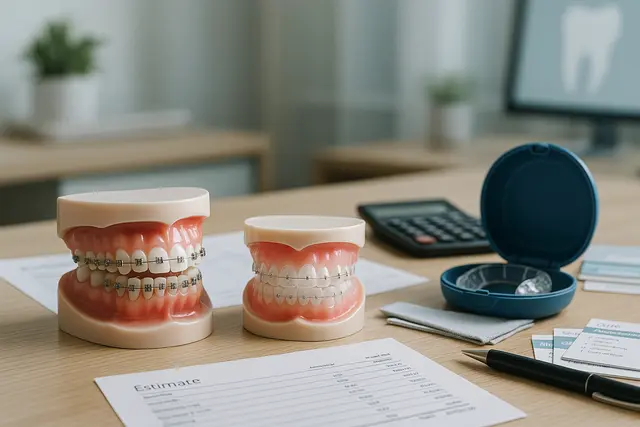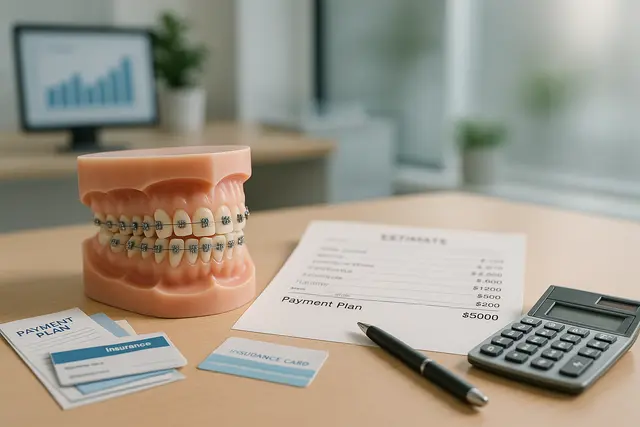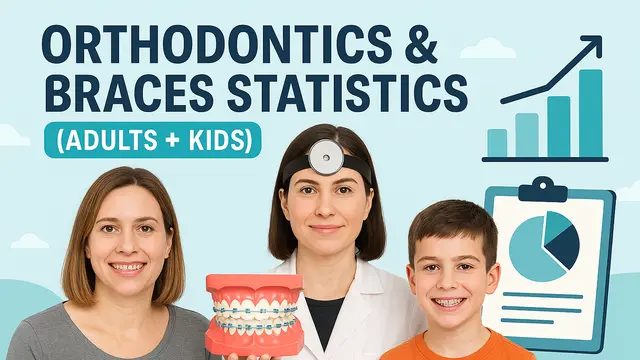Orthodontics
6 min read
Apr 03, 2025
Braces for Adults: Overcoming Challenges and Expectations
When most people think of braces, they think of teenagers, with good reason. Historically, orthodontic treatment has been associated with adolescence, a time when jawbones are still developing and tooth movement tends to be faster and more straightforward. But the landscape is changing. Adult orthodontic treatment is steadily on the rise, driven by a mix of health concerns, cosmetic goals, and long-term dental maintenance.

You’re standing in front of the mirror, brushing your teeth before work, and you can’t help but notice, again, that one crooked tooth doing its own thing in an otherwise good smile. Maybe it’s not just one. Maybe it’s crowding, shifting, or the fact that your bite hasn’t felt quite right in years. And then it hits you: "Should I get braces… as an adult?"
Here’s the thing: braces aren’t just for teens anymore. In fact, adult orthodontic treatment is more common than ever. Whether you're looking to straighten your teeth for cosmetic reasons, oral health, or just to finally tackle that misalignment you’ve ignored since high school, there’s a solid chance the braces you choose today could bring the smile you’ve always wanted, and a whole lot more.
Let’s talk about what that journey looks like.
Why Braces for Adults Are More Common Than You Think
Many adults are finally embracing what used to feel like a teenage rite of passage: orthodontic treatment. Whether it’s because dental insurance plans now offer more options, or just because adult orthodontics is more discreet and accessible, grown-ups are stepping up.
Some are correcting issues left untreated in their youth, like crowded teeth, overbites, or crooked teeth. Others are addressing problems caused by shifting teeth due to aging, gum disease, or even past dental work that didn’t age well. Properly aligned teeth can help reduce the risk of tooth decay and gum disease, so it’s not just a vanity thing, it’s a health thing, too.
Your Orthodontist Is Not Judging You
Here’s something that surprises a lot of folks: orthodontists love adult patients. You show up to your appointments. You follow the treatment plan. You care about results. Whether you're going for traditional metal braces or leaning toward something less noticeable, your orthodontist’s job is to help you find the best treatment plan for your needs.
Worried about the braces cost? Ask upfront. Some dental insurance will help, especially if your issues are causing pain or difficulty chewing. And there are more flexible financing options than ever, just don’t assume you can’t afford it until you ask.
Braces Aren’t What They Used to Be
Forget what you remember from middle school. Today’s braces offer sleek designs, advanced materials, and multiple options for adults who don’t want their orthodontic treatment to steal the show.
Here are some of the different types of braces you might consider:
Traditional metal braces: Yes, they’re still around. And for good reason. Metal braces use brackets and wires to gradually shift your teeth. They’re durable, effective, and often the most affordable treatment option. Sure, braces are still visible, but they’re smaller and smoother than the bulky versions of the past.
Ceramic braces: Similar to traditional metal braces, but made with clear or tooth-colored materials that blend in. Ceramic braces and clear aligners are ideal for adults who want a less noticeable treatment without sacrificing power.
Lingual braces: These are attached to the back of your teeth, totally hidden when you smile. Lingual braces take some getting used to (your tongue might protest for the first few weeks), but they’re a great fit for adults who want discretion.
Self-ligating braces: These are similar to traditional braces but use a special clip instead of elastic bands to hold the wire in place. Self-ligating braces work faster for some people and may require fewer office visits.
And of course...
Let’s Talk Invisalign (and Other Clear Aligners)
Invisalign and other clear aligners have completely changed the game. These removable trays are custom-molded to your teeth and gradually shift them into place. No metal, no brackets, and you can take them out when you eat or brush.
Clear aligners are a great choice for adults with mild to moderate dental issues. You’ll need discipline, they have to be worn 20 to 22 hours a day to work, but they’re virtually invisible, and brushing and flossing is a breeze.
Not everyone is a candidate for Invisalign, though. Some cases involving severe misalignment or bite correction may need braces. That’s why a consult with an orthodontist is key. And if you’re wondering how you’ll pay for Invisalign aligners, ask about dental insurance or payment plans that can help offset the cost.
Managing Expectations: What to Know Before You Get Braces
So you’ve decided to go for it. Great! Now let’s get real about what’s ahead.
First, treatment time varies. For adults, it can take 12 to 36 months depending on how complex your case is and the type of braces you choose. Braces may require more time if your bones have stopped growing (as they tend to in adulthood). But don’t let that scare you, many orthodontic patients say the time goes by faster than expected.
Second, yes, braces can be uncomfortable at first. Your teeth and jaws are getting a wake-up call. Brackets and wires may cause soreness or irritation in the first few days after tightening. Clear aligner wearers often feel tightness when switching to a new tray. But this discomfort is temporary and manageable with wax, soft foods, and over-the-counter pain relievers.
Third, oral hygiene is non-negotiable. Braces make brushing and flossing trickier, and misaligned teeth can already put you at risk for tooth decay and gum disease. You’ll want to keep your teeth clean, use a water flosser or interdental brush, and schedule regular cleanings with your dentist.
A Word on Adult Life With Braces
Here’s something people don’t talk about enough: emotional ups and downs. You might feel self-conscious at first. You may second-guess your decision when you catch a glimpse of metal in a Zoom call. That’s normal.
But you’re also going to have some proud moments. Like the first time you see a real difference. Or when you realize your teeth and gums are healthier than they’ve ever been. Or when you catch yourself smiling bigger in photos without even thinking about it.
And if you need a little pep talk? Remember: braces are a great investment in your health, confidence, and long-term dental care. Adult orthodontic treatment isn’t just about teeth, it’s about how you feel when you walk into a room.
Choosing the Right Type of Braces for You
The type of braces you choose depends on your goals, budget, and lifestyle. Adults who are concerned about appearance might lean toward ceramic braces, clear aligners, or lingual options. Those with more severe misalignment may need traditional or self-ligating braces to get the job done right.
Your orthodontist will walk you through all the options available and help you choose what works best. No one-size-fits-all here. You deserve a treatment plan that’s just as unique as your smile.
Adult Orthodontic Benefits That Go Beyond Looks
Yes, straighter teeth look great, but that’s not the only payoff. Braces improve oral health by making teeth easier to clean, reducing the risk of gum disease, and aligning your bite for better chewing and speech.
Misaligned teeth can create strain on your jaw, uneven tooth wear, and even headaches. Adult orthodontics can correct these issues before they turn into bigger problems. And properly aligned teeth can make dental visits smoother, too, your dentist will thank you.
Final Thoughts From One Adult to Another
If you’re still on the fence about getting adult braces, here’s the truth: you’re not too old, it’s not too late, and yes, you can absolutely handle this.
From ceramic braces and clear aligners to traditional metal options and everything in between, today’s orthodontics gives you the power to straighten your teeth without sacrificing your lifestyle. Braces and orthodontic treatments are more refined, more comfortable, and more adult-friendly than ever.
So whether you're fixing crowded teeth, tackling long-standing dental issues, or just ready for the beautiful smile you’ve always wanted, this might be your moment. Consult with an orthodontist, explore the type of braces you choose carefully, and take that first step.
Because at the end of it all? Straighter teeth are just the beginning. The real win is confidence, and that never goes out of style.
Is It Normal for Adults to Get Braces?
Absolutely. Adult braces are more common than ever, with many people choosing treatment to correct long-standing issues like crowding, bite problems, or shifting teeth. Advancements in orthodontics have made braces and aligners more discreet and accessible, and adults often make ideal patients because they’re motivated and consistent with care.
What Are My Options for Braces as an Adult?
Adults can choose from several orthodontic options, including traditional metal braces, ceramic braces, lingual braces (which go behind the teeth), and clear aligners like Invisalign. Each has pros and cons based on visibility, comfort, cost, and how complex your case is. An orthodontist will help determine which is best for your needs and goals.
How Long Does Adult Orthodontic Treatment Usually Take?
Treatment time varies by case, but most adults wear braces or aligners for 12 to 36 months. More complex cases may take longer due to slower tooth movement in mature bone. However, with consistent care and regular checkups, many patients see steady, satisfying progress throughout treatment.
Are Braces Really Worth It for Adults?
Yes, braces can offer major benefits beyond just aesthetics. Straight teeth are easier to clean, which reduces the risk of tooth decay and gum disease. Correcting bite issues can relieve jaw pain and prevent uneven wear on teeth. And for many adults, the boost in confidence from a healthier, straighter smile is life-changing.
Read Next
Related Posts

Orthodontics
Retainer That Looks like Braces: Benefits for Long-Term Alignment
A retainer might not get as much attention as braces, but it plays a crucial role in maintaining your smile after orthodontic treatment. Whether you're new to retainers or curious about the type that looks like braces, understanding their purpose and benefits is key to keeping your teeth aligned for the long haul.
6 min read
Sep 15, 2025

Orthodontics
How Much Are Metal Braces? Cost Comparison With Other Options
Thinking about getting braces but overwhelmed by the cost? You’re not alone. Orthodontic treatment can be a major investment, and understanding the different price points, from metal braces to clear aligners, can help you make a smart, confident decision.
5 min read
Sep 15, 2025

Orthodontics
Orthodontics & Braces Statistics (Adults + Kids)
Orthodontics has transformed from a niche medical service for teenagers into a booming sector that spans all ages. Today, both adults and children seek orthodontic treatment to improve their smiles, fix bite issues, and boost self-confidence.
4 min read
Aug 21, 2025
Don’t have time to research every dentist around you?
See why 30k+ patients trusted us